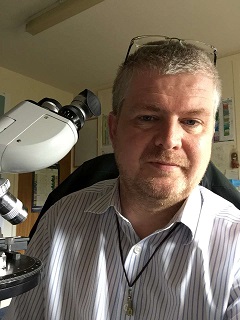
Richard Price is a biostratigrapher and geologist with Robertson, a CGG company based in North Wales. The company is a longstanding, large geoconsultancy business for the oil and gas industry, employing a wide range of specialists, including micropalaeontologists, palynologists and nannopalaeontologists. Richard has spent the last 11 years working both on- and offshore, primarily as a nannopalaeontologist (Jurassic–Pleistocene), at diverse locations around the world, helping oil companies to age-date the rocks they are drilling through and interpret the stratigraphy at any given location. Richard started his career by studying the plant kingdom as a horticulturalist for the National Trust before embarking on a degree in Plant Biology (Hons) at Bangor University in 1999, where he was first introduced to palynology. An MSc in Taxonomy followed in 2002–2003 at the University of Edinburgh, where he studied further aspects of palaeontology and palynology.
Q&A
Describe yourself in three words.
Reliable, focused, hardworking.
How did you first get interested in palaeontology?
When I was a child my father, a civil engineer, taught me about rocks and fossils and we had a small collection at home. I don’t think I really got interested until I went to Bangor University and studied rocks and fossils as a part of my degree course, in the context of plant evolution.
What are the main responsibilities of your job?
The main responsibilities are to accurately analyse fossil assemblages in rock samples using a microscope and to provide high-quality biostratigraphy reports for oil companies on time and on budget, as well as supplying accurate real-time data during offshore drilling.
What is your favourite fossil and why?
Probably one of the Discoasteraceae such as Discoaster signus, a beautiful nannofossil with a wonderfully descriptive Latin name that translates as ‘daisy wheel’ and is also a useful marker fossil restricted to the Middle Miocene.
In an average week, how many hours do you work?
This varies enormously. Standardly, we are contracted to work a regular 37.5 hour week during normal office hours, but this increases to 84 hours a week whilst working offshore doing 12 hour shifts (day or night) for up to four weeks at a time.
How many people do you work with on a daily basis?
Our departmental team of biostratigraphers totals around 26 at present, made up of micropalaeontologists, palynologists and nannopalaeontologists, but we also work closely with the other geoscientists on site including sedimentologists, geophysicists and geochemists, plus technicians and support staff, so around 200 people in all.
What are the worst things about your job?
Having to do lots of form filling, quality control paperwork, compulsory health and safety courses etc. These things just eat into your time for doing the more interesting stuff like looking at fossils under the microscope. Planning your home life can also be frustrating if working offshore as you can be constantly on call and may need to travel at short notice for undetermined lengths of time.
Do you get to do much overseas travel for work and do you do much fieldwork?
There are lots of opportunities to travel the world in this profession, either whilst working offshore or on associated promotional trips. I have been fortunate to visit a wide range of countries that I would never have dreamed of going to 15 years ago.
Has there been a paper or book that has influenced your career?
The first two palaeontology books that inspired me were both PalAss publications acquired as an undergraduate at Bangor University. They were Plant Fossils of the British Coal Measures (Cleal & Thomas) and Fossil Plants of the London Clay (Collinson).
Who have been the most important mentors in your career so far?
Dr Adrian Bell (Bangor University) for having the faith to accept me onto the undergraduate course in Plant Biology as a mature student lacking in formal qualifications. Also Nigel Brown (Bangor University): his knowledge of the natural sciences is immense and he introduced me to palynology and palaeobotany as an undergraduate.
What skills does it take to be successful in your job?
Logical thinking and problem solving are essential, as are being able to work under pressure and alone with a microscope for long periods, away from family and friends. The rest is down to lots of hard work training and self-learning all of the fossils and their names.
Do you have any tips for students who would like to take a similar career path?
A higher degree is essential. I would say try and focus on one discipline that you like and find out as much as you can about it before taking the plunge, especially if you are thinking of doing a PhD. As a multidisciplinary MSc graduate, switching disciplines very early in your career is not usually a problem as extensive training is always beneficial.
Are there any major obstacles to being successful in a career like yours?
Around the time I graduated there had been a general decline in all plant sciences including the demise of the MSc in Palynology at the University of Sheffield, followed not long after by the MSc in Micropalaeontology at UCL. Things have now improved with a new MSc course at the University of Birmingham providing students with an excellent grounding and postgrad job opportunities. However, the current oil price crash has seriously affected recruitment opportunities for new people entering the oil industry for the first time in many years.
What’s the best thing about your job?
Travelling the world to strange and exotic places.
If you could have dinner with a famous palaeontologist (living or dead), who would you choose?
Charles Darwin. He was seeing the bigger picture when he came up with his theory of evolution and he challenged conventional wisdom. These are important factors for good science and all scientists in academia and industry should remember these.
For biostratigraphy jobs the following websites may be useful, as well as individual company websites:
